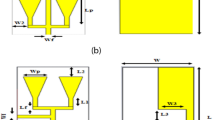Abstract
In this paper, I propose a new design of a defected structure (DS) for use as an electromagnetic band gap (EBG) configuration to enhance the performance of low profile microstrip antennas. The proposed defected structure embodies a honeycomb lattice of cylindrical air holes. The proposed DS is applied to three different configurations using a dielectric substrate (dielectric constant 6 and thickness 1.5 mm); namely: a dielectric substrate backed by a defected ground plane, a defected dielectric substrate backed by a normal substrate and a defected dielectric substrate backed by a defected ground plane. The simulated values of the transmission coefficient S 21 for the last one show two well-defined stop bands around 8.5 and 9.5 GHz, respectively. The first band has been used to reduce mutual coupling in a microstrip array. On the other hand, the stop band defined around 9.5 GHz has been applied to enhance the characteristics of a rectangular patch antenna and improve the operational 10-dB bandwidth.
Similar content being viewed by others
References
M. Qiu, Computational Methods for the Analysis a nd Design of Photonic Band Gap Structures, Ph.D. thesis, Royal Institute of Technology, Stockholm (2000)
J.M. Lourtioz, H. Benisty, V. Berger, J.M. Gerard, D. Maystre, A. Tchelonkov, Photonic Crystals. Towards Nanoscale Photonic Devices (Springer, Berlin, 2005)
R. Gonzalo, G. Nagore, Simulated and measured performance of a patch antenna on a 2-dimensional photonic crystal substrate. Prog. Electromagn. Res. 37, 257 (2002)
F. Yang, Y. Rahmat-Samii, Microstrip antennas integrated with electromagnetic band-gap (EBG) structures: A low mutual coupling design for array applications. IEEE Trans. Antennas Propag. 51(10), 2836 (2003)
D. Sievenpiper, L. Zhang, R.F.J. Broas, N.G. Alexopolus, E. Yablonovitch, High-impedance electromagnetic surfaces with a forbidden frequency band. IEEE Trans. Microw. Theory Tech. 47, 2059 (1999)
Taflov, S.C. Hagness, Computational Electrodynamics—The Finite Difference Time Domain Method. 3rd edn. (Artech House, London, 2005). http://www.artechhouse.com/Detail.aspx?strBookId=1123
S.-M. Shum, K.-M. Luk, FDTD analysis of probe-fed resonator antenna. IEEE Trans. Antennas Propag. 46(3), 1361 (1998)
D.M. Sheen, S.M. Ali, M.D. Abouzahra, J.A. Kong, Application of the three-dimensional finite-difference time-domain method to the analysis of planar microstrip circuits. IEEE Trans. Microw. Theory Tech. 38(7), 849 (1990)
Author information
Authors and Affiliations
Corresponding author
Rights and permissions
About this article
Cite this article
Areed, N.F.F. Rectangular patch antennas over electromagnetic band gap structures. Appl. Phys. A 103, 561–566 (2011). https://doi.org/10.1007/s00339-011-6354-8
Received:
Accepted:
Published:
Issue Date:
DOI: https://doi.org/10.1007/s00339-011-6354-8




